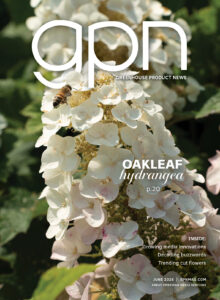Dr. Bugs: Biological control agent of Western flower thrips
Answer: The predatory mite you are referring to is Neoseiulus, also known as Amblyseius cucumeris. Neoseiulus cucumeris can be released into greenhouse production systems to manage Western flower thrips (Frankliniella occidentalis) populations on ornamental and vegetable crops below plant-damaging levels. This article discusses the biology and behavior, commercial availability and use of N. cucumeris in greenhouse production systems.
BIOLOGY AND BEHAVIOR
Neoseiulus cucumeris adults are 0.4 to 0.8 millimeters long, pearshaped and light brown (Figure 1). The life cycle consists of an egg, larva, two nymphal stages and an adult. The life cycle, from egg to adult, can be completed in 6-12 days at 77° F.

Each adult female can lay up to 35 eggs during her 35-day lifespan. Eggs are 0.14 millimeter in diameter and white. Females lay eggs on the leaf underside along the midrib. Nonfeeding, six-legged larvae emerge (eclose) from eggs in two to three days at 68° F. Two nymphal stages (deutonymph and protonymph) are present for 7-10 days before becoming adults. The nymphal stages and adults have eight legs.
Development of the life cycle from egg to adult varies with temperature. The life cycle takes 11 days at 68° F, eight days at 77° F and six days at 86° F. The nymphal stages and adults are mobile and actively search for Western flower thrips larvae. Neoseiulus cucumeris is most active at temperatures between 68º F and 81° F and a relative humidity between 65% and 80%.
This predatory mite is generally located on leaf undersides, along leaf veins and in flowers. It feeds on the immature (larvae or nymphs) stages of insect and mite pests including: sweetpotato whitefly (Bemisia tabaci); Western flower thrips; broad mite (Polyphagotarsonemus latus); cyclamen mite (Phytonemus pallidus) and tomato russet mite (Aculops lycopersici). Larvae and adults only feed on the first instar (stage between each molt) larvae of the Western flower thrips.
Their mouthparts are used to pierce Western flower thrips first instar larva and withdraw body fluids. Western flower thrips second instar larvae and adults defend themselves by striking N. cucumeris with their abdomen, which is why N. cucumeris only feed on Western flower thrips first instar larvae. In addition, Western flower thrips produce a liquid substance that covers the body of N. cucumeris. Consequently, N. cucumeris will not attack Western flower thrips but instead will spend time cleaning (grooming) themselves.
Neoseiulus cucumeris feeds on pollen as an alternative food source, which sustains its populations when Western flower thrips populations are low or when they are not in a susceptible life stage (first instar larva). Temperature can affect the number of Western flower thrips killed by N. cucumeris with feeding reduced when temperatures are less than 68° F.
COMMERCIAL AVAILABILITY AND USE IN GREENHOUSES
Neoseiulus cucumeris are available from most distributors or suppliers of biological control agents as sachets or slow release bags (Figure 2) that contain eggs, immatures (larvae and nymphs) and adults mixed with a bran carrier. The sachets also contain bran mites (Tyrophagus putrescentiae) as a temporary food source. Sachets are placed within greenhouse grown crops (Figure 3). This predator emerges over a 4-6 week period. Most N. cucumeris emerge from the sachets in the first week. Adults emerge from the sachets through small holes, and then disperse among greenhouse crops when plant leaves are touching. Sachets need to be in contact with plant leaves or stems so when predatory mites emerge from the sachets they can move onto plants and start searching for Western flower thrips larvae.
Figure 2. A sachet, or slow release bag, containing Neoseiulus cucumeris adults, nymphs and eggs.
Figure 3. Sachets of Neoseiulus cucumeris are placed throughout a greenhouse grown crop to control Western flower thrips.
It is also available in containers of 20,000 predatory mites mixed with vermiculite (Figure 4). The predatory mites are distributed onto crops by placing them onto plant leaves (Figure 5) or using a mechanized blower (Figure 6). Be sure to lightly mist plants with water before releasing so the predatory mites do not fall off plants. N. cucumeris take 3-4 weeks to establish within a crop, so releases should be made early in the crop production cycle when Western flower thrips populations are low.
Figure 4. A container of 20,000 Neoseiulus cucumeris mixed with vermiculite.
Figure 5. Neoseiulus cucumeris can be applied by hand directly to leaves.
Figure 6. A mechanical sprayer can be used to distribute Neoseiulus cucumeris in the greenhouse.
The ability of Neoseiulus cucumeris to manage western flower thrips populations depends on the length of the crop production cycle. For example, a short production cycle (2-3 months), such as for bedding plants, may not allow enough time for populations of this predator to establish an increase in numbers to manage Western flower thrips populations below plant-damaging levels. Consequently, N. cucumeris may be more effective in managing Western flower thrips populations on long production cycle crops (greater than three months) such as vegetables.














 Video Library
Video Library 


















